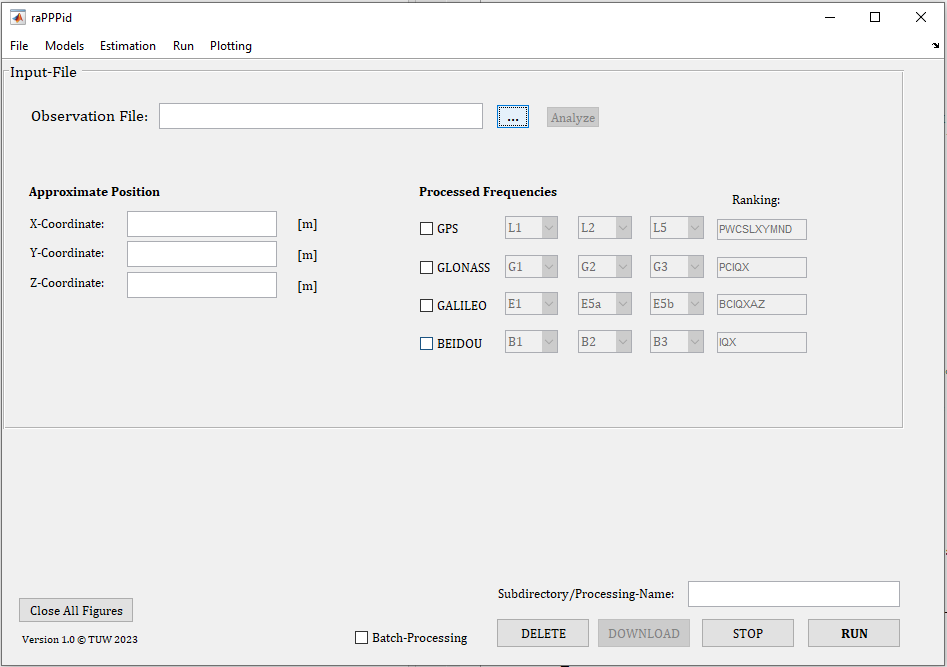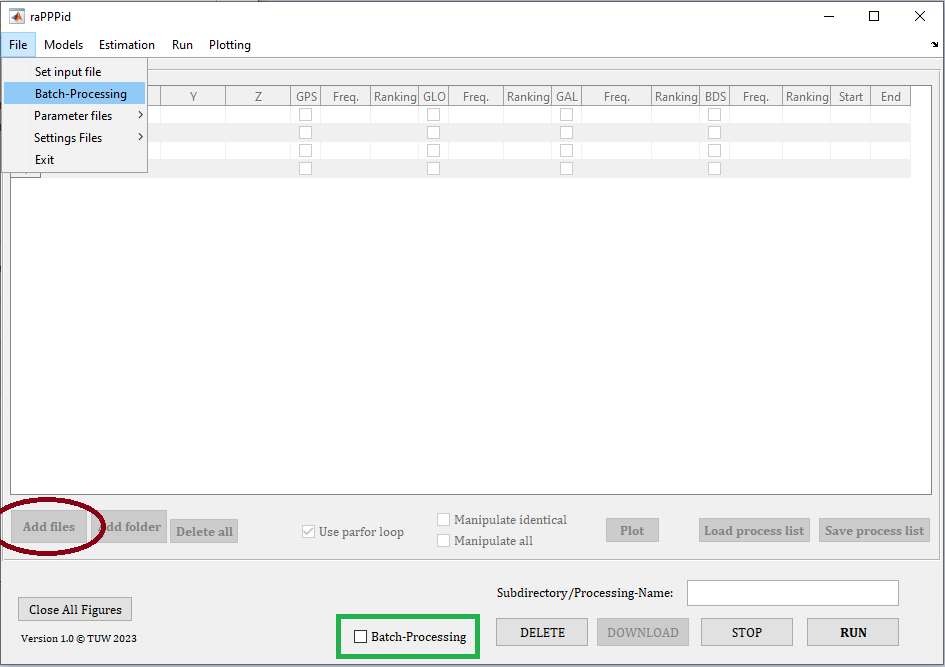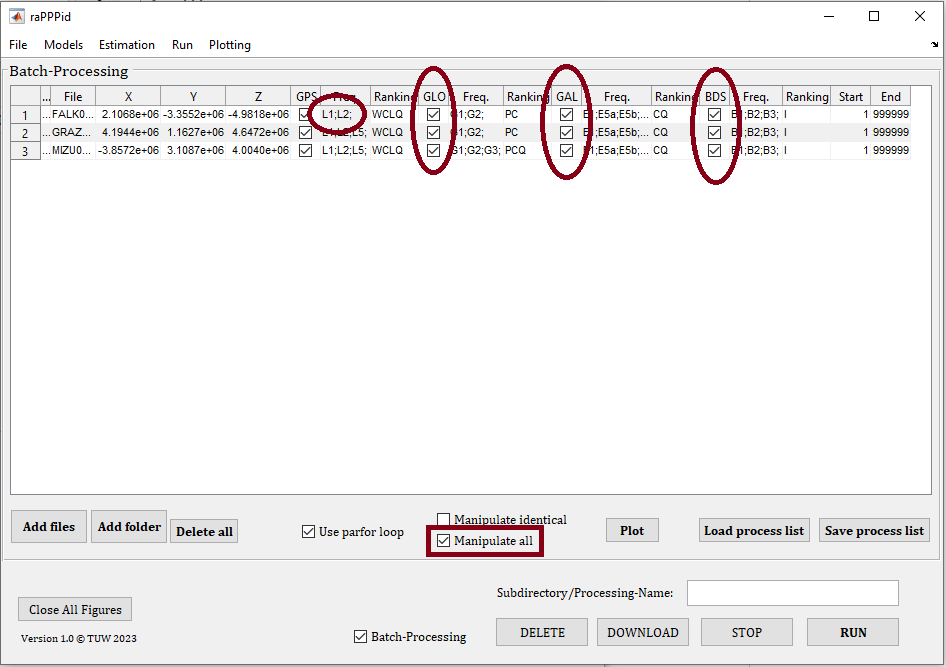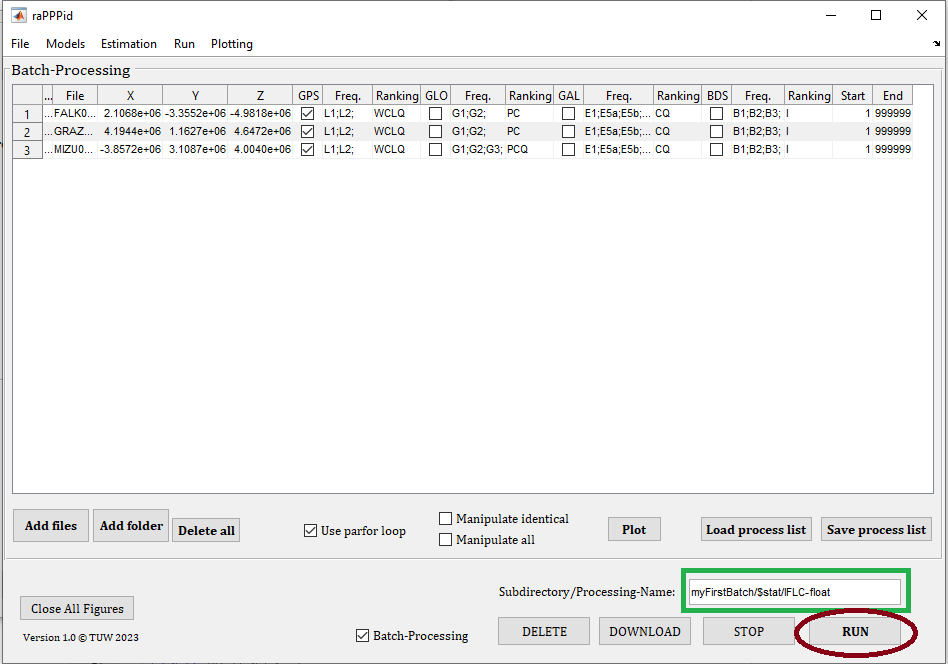Download raPPPid from GitHub and follow the instructions provided in the README
Open Matlab and navigate to the WORK folder of raPPPid. Start the GUI with
raPPPid()Please note that the GUI might look slightly different depending on your raPPPid version.

To perform your first batch processing, you will need multiple RINEX observation files (batch processing is the processing of many observation files with the same processing settings). You can download RINEX observation files which will be saved in the raPPPid data folder automatically. Note that the following command will only work after you have opened the GUI and the folders have been added to the Matlab search path.
DownloadDaily30sIGS({'GRAZ00AUT', 'MIZU00JPN', 'FALK00FLK'}, 001, 2020) % downloadChange to the panel Batch-Processing.

Enable the “Batch-Processing” checkbox. You need to load your RINEX observation files into the GUI with the pushbutton 'Add files' in the bottom left. Navigate to the folder of the year and the subfolder of the day where your RINEX observation files are located. Select, for example, the three downloaded observation files or those you like. Generally, you can add as many observation files as you like, for example, from different days or stations.
You should now have added the RINEX observation files to the batch processing table. Each row of this table corresponds to a RINEX observation file which raPPPid will process. The GNSS, frequencies, and observation ranking for each observation file are defined in the table for each row/observation file. All other settings are taken from the GUI. For your first processing, please disable all other GNSS except GPS and process only GPS L1 and L2. You can use the '"Manipulate all rows'' checkbox to do this. Keep the settings on the other panels like they are.

Your GUI should look similar to the provided screenshot.

You can insert a subdirectory and name for the processing, as shown in the screenshot. Remember that raPPPid will add a prefix ‘G’ because (only) GPS observations are used in the processing. $stat will create a subfolder for the station. For the setup above, the results will be saved to the following folders ($date corresponds to the processing date):
...\RESULTS\G-myFirstBatch\GRAZ\GRAZ00AUT_R_20200010000_01D_30S_MO\IFLC-float_$date
...\RESULTS\G-myFirstBatch\MIZU\MIZU00JPN_R_20200010000_01D_30S_MO\IFLC-float_$date
...\RESULTS\G-myFirstBatch\FALK\FALK00FLK_R_20200010000_01D_30S_MO\IFLC-float_$dateEnable the ‘Batch-Processing’ checkbox and hit the ‘RUN’ button to start your first batch processing. The processing will take 1-2 minutes, depending on your machine.
Note that raPPPid offers the option to use parallelization for batch processing, which usually dramatically reduces the processing time. However, this option requires the Parallel Computing Toolbox. Therefore, the default option (parallelization OFF) does not require any Matlab toolbox. If a user has access to the Parallel Computing Toolbox, the parallelization option can be activated by checking the ‘Use parfor loop’ button as shown in the next screenshot. Otherwise, raPPPid, by default, simply processes one file after the other (parallelization OFF).

If only the processing of single files fails during batch processing (e.g., an input file was temporarily unavailable), you will be informed after the batch processing is finished (e.g., in the info window). Furthermore, raPPPid saves these rows of the Batch Processing Table into LastFailed.mat. This LastFailed.mat can easily be loaded into the Batch Processing Table for reprocessing.
After some time, your first batch processing should be successfully finished, and you will get an info window. Now you can create Single-Plots or Multi-Plots on the corresponding panel of the GUI.

Well done, you have successfully finished your first batch processing! You have processed three observation files with the same settings: a GPS-only float solution for all data included in the RINEX observation file. IGS final satellite orbit & clock products and CAS Multi GNSS DCBs were used. raPPPid created output for all processed files. You should check the RESULTS folder (OpenResultsFolder).
Not bad for the first try. Now you should play around with different settings and check the results. Use other GNSS too! Insert a reset to e.g., every full hour - then you can create even more meaningful Multi-Plots and study the convergence behavior.
Jump to Table of Content